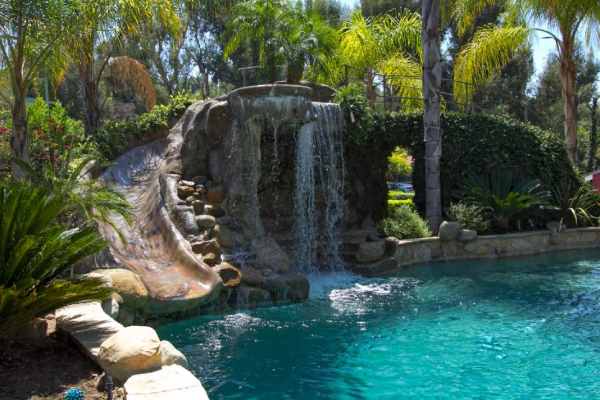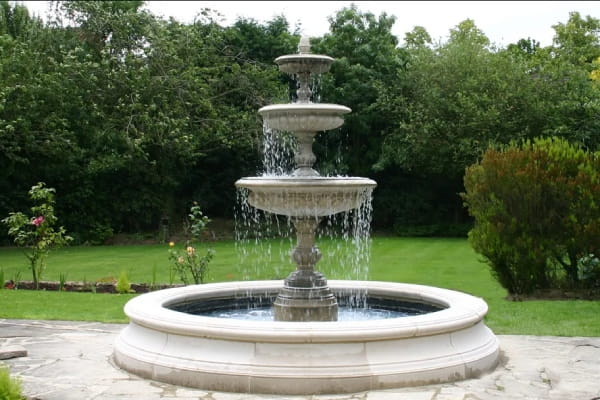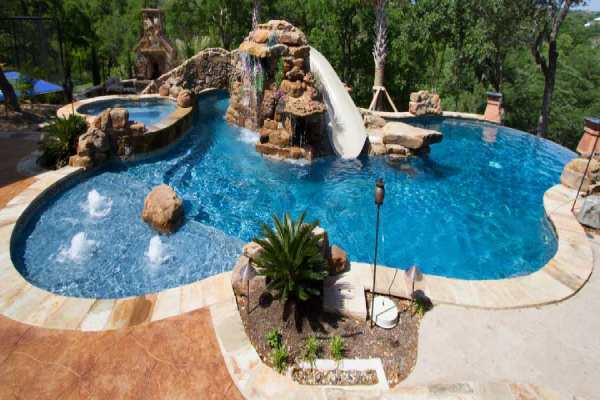How to Stop a Fountain from Splashing [Indoor & Garden]
Fountains are a wonderful way to enhance the beauty and serenity of your outdoor space. It adds elegance and tranquility to your outdoor space.
However, excessive splashing is a common issue that over 67.5% of fountain owners face. You know, splashing not only wastes water, it can potentially damage nearby buildings and also creates a mess.
To ensure that you have a relaxing and delightful fountain in your indoor or outdoor space, we will discuss how to stop a fountain from splashing in this blog post so, keep scrolling.
How to stop an indoor fountain from splashing
Have you ever asked yourself this question “How do I stop a fountain from splashing?” If yes, then keep reading because, in this section, we will discuss that in detail.
Verification that the Fountain is Level
Making sure the fountain is level is an important step in avoiding splashing. An uneven fountain can cause water to shoot out in all directions. Check whether your fountain’s various components, like the basin, the tiers, and the top surface area leveled using a spirit level.
The fountain is level when the bubble in the spirit level is in the middle, so make any necessary adjustments to the base or pedestal.
Check that the fountain is sitting firmly on its base. Shim the base if necessary or readjust it until the shaking stops.
What is the Water Level Like?
The water level in a fountain is a major factor in determining the frequency and intensity of splashing. You know, it is important to strike a balance between having enough water to maintain the fountain’s functionality and preventing excessive splashing.
The ideal water level for most fountains is clearly indicated. Adhering to this rule is critical, as it guarantees enough water circulation and prevents mechanical faults that could lead to splashing.
Splashing may be exacerbated if the water in the fountain is too shallow for the pump’s intended depth of operation.
Also, water overflowing the basin is one common issue that might result from having too much water depth. So, it’s important to find the right balance.
Placing a Screen at the bottom of your Fountain
One method to reduce water splashing from a fountain is to install a screen at its base. While the soothing sound of running water from a fountain may be pleasing, the splashing sound can be an annoyance if the fountain is placed inside or in a small room.
Splashing can be greatly reduced, and water flow can be better managed by installing a screen at the base of the fountain.
The screen functions as a barrier, preventing the water from shooting up too forcefully and causing excessive splashing.
This method is excellent if your fountain contains powerful water jets or cascading features.
The screen material should be long-lasting and waterproof. Common materials you can use include stainless steel or a strong plastic mesh.
Controlling the Force of the Fountain
The amount of water splashed can be reduced by adjusting the force of your fountain. By adjusting the pump, flow rate, pressure, and direction of the water, you can achieve a more controlled and gentle display, minimizing the unwanted splashing effect.
This method is useful when your fountain is installed in a restricted area or close to delicate materials. The force of the water can be adjusted by the pressure settings if your fountain has a pump or a water supply with variable pressure.
By decreasing the pressure, the fountain’s water can be released more gently and with less splashing.
Smooth Rocks or Other Decorative Items to Prevent a Splash
Splashing can be avoided in a fountain in an original and visually pleasant way by placing smooth rocks or other decorative items in the water’s path.
You can reduce the force of the water jets and the amount of splashing that occurs by placing these objects in the fountain basin. Using rocks to stop a fountain from splashing works best when natural components are used.
Choose water-resistant and long-lasting materials when shopping for smooth rocks or other fountain ornaments.
Popular options include smooth river boulders, polished stones, and ceramic vases. These materials improve the fountain’s aesthetics while also lessening splashing.
Installing a Splash Guard to Protect from Damages
Despite their aesthetic and entertaining value, fountains can be a source of unwanted splashing when the water hits the surface at a rapid speed. Because of this, water may spill out of the fountain basin, resulting in wet floors, accidents, and more upkeep.
But the good news is that the fountain’s water supply can be protected from overspray by installing a splash guard around its perimeter.
The splash guard functions as a barrier, catching the falling water and sending it gushing back into the fountain, where it belongs.
In order not to obscure the view of the fountain, splash guards are often made of transparent or translucent material like acrylic or tempered glass.
Switching to a Smaller Pump and Reducing the Piping
Issues such as water waste, maintenance difficulties, and potential dangers arise when your fountain splashes too much.
You can reduce splashing and enhance your fountain’s performance by adjusting the size of the pump and making adjustments to the piping system.
The quantity of water flowing through your fountain and its rate of movement are both directly proportional to the size of the pump.
An excessive amount of splashing can occur if the pump is too powerful for your fountain’s needs. So, you can reduce splashing by using a smaller pump suited to your fountain’s demands to regulate water flow.
Fishline Leader Strings
The use of fishline leader strings to prevent water from splashing out of fountains is a common and successful method that has gained popularity among fountain enthusiasts.
To reduce splashing and produce a more manageable water flow, the fishline leader strings are positioned strategically within the fountain’s framework.
Thin, sturdy, and transparent, fishing leader lines are constructed from materials like nylon or fluorocarbon.
In fishing, they are used to make leaders, which are the pieces of line that go from the line to the hook or lure. The same properties that make fishline leader strings suitable for fishing applications also make them well-suited for controlling water splashing in fountains.
Keep the kids away
You can reduce splashing and keep the fountain more peaceful by posting rules and installing barriers to keep children at a safe distance.
The area around the fountain should be well-marked with signs warning kids not to play in or around the fountain. To maximize the impact of your message, use language and visual signals.
Waterproof the Surrounding Area
When installing an indoor or outdoor water fountain, it is important to consider how to control the splash of a fountain you intend to install, and another way of doing that is to waterproof the area around it.
By constructing a watertight wall around the fountain, you may reduce the amount of splashing that occurs outside the allotted space.
Waterproofing the fountain properly means using materials that are compatible with the surfaces already in place. Waterproof membranes, coatings, sealants, and liners are frequent choices. To find the best materials for your needs, talk to a supplier or professional.
Aesthetically Pleasing Plants
Splashing water in fountains can be greatly reduced with the strategic placement of aesthetically beautiful plants.
As an added advantage to its functional purpose of decreasing splashing, it enhances the aesthetic value of the area by introducing natural texture and a sense of balance.
Pick vegetation that thrives in damp environments. Plants that thrive in damp environments include water lilies, papyrus, irises, and horsetail reeds. Also, choose vegetation with lovely foliage and textures to increase aesthetic appeal.
Turn Your Water Feature into a Snow Globe
A sleek glass dome placed at the top of your water feature is an easy way to solve the problem of splashing without detracting from its aesthetic value. The glass dome serves two purposes: it prevents water from gushing out and gives your feature a fun snow globe look.
Having a glass dome over your water fountain protects it from the elements. The water flow is not interrupted by dirt, debris, or other undesirable substances since the dome acts as a shield. The glass dome provides an unobstructed view of the water feature, so its beauty can be appreciated in all its glory.
A glass dome can also help muffle the sound of your indoor water fountains while adding to their visual value. The enclosure muffles the trickle of water, making your home more conducive to rest and relaxation.
What to be Aware of and What to Avoid
It is important to be aware of potential problems and take specific precautions when installing an indoor or outdoor water fountain to ensure maximum performance and upkeep. Here are what you should be aware of and what to avoid;
Location
Locate your water feature in an appropriate area, especially on a surface that is watertight or resistant to water damage. If the fountain spills or splashes, you won’t have to worry about any damage.
Decoration
Don’t cram too many things into the space around your water feature. If these things are in the way, the water will have to splash around more. The beauty of the fountain should be the focal point, not the decorations around it.
Netting
The effectiveness of the fountain may be diminished if netting or screens are used to control the water. These barriers can also get obstructed by dirt, dust, or other debris. Such additions should be avoided unless absolutely necessary.
Maintenance
A glass cover over the water feature may make routine cleaning more of a chore. However, if you put in the time and effort, you can keep your fountain sparkling clean.
Pump size
Seek expert advice when deciding on a new water pump size or resizing an existing one. If the water flow from the pump is insufficient, the fountain will not work properly or may stop working completely. A professional can guide you to the best option for your needs.
Plant placement
It’s tempting to surround your fountain with lots of plants for aesthetic reasons, but remember that too many plants can block the view and take away from the fountain’s overall charm. Keep the water feature visible while still allowing plants to flourish around it. Meanwhile in case of loss of water here’s a guide on how to keep fountain water from evaporating.
Piping
The diameter of the pipe utilized in your fountain must be suitable for the flow of water. If you want to know what size pipe would work best for your fountain, you should ask an expert.
Splash Guard
When designing a splash guard to prevent water from splattering, keep in mind that it may blend seamlessly with the overall design. You can use your creativity to create a splash guard that matches the aesthetic of the fountain.
Water Level
The water level should be kept within the specified parameters at all times. Your fountain’s functionality may suffer if the height is set too high or too low. If your fountain stops working because of a lack of water, you can easily fix it by refilling it.
Conclusion
Controlling the amount of water that splashes out of a water fountain calls for a blend of innovative thinking and attention to detail.
By using a combination of the methods described in this article, you can make your water fountain the focal point of your outdoor space while still enjoying the relaxing sounds of water without being bothered by splashing.
Use your creativity while applying these methods to design an outdoor space that will enchant and please visitors.
FAQs
An uneven fountain, excess water, too much water pressure, or a poorly designed fountain are all potential causes of excessive splashing in a water fountain.
Make sure the basin and the levels of the fountain are perfectly leveled using a spirit level. Also, make sure the water flows evenly and that there is minimal splashing by adjusting the pedestal or base of the fountain.
Keep the water in your fountain at the level suggested by the manufacturer. If the water is too shallow, it may cause more splashing, and if it is too deep, it may overflow.


![Here’s Why Your Fountain Loses Water [9 Reasons & Quick Fix]](https://pondmemo.com/wp-content/uploads/2023/11/why-your-fountain-loses-water-IMG_1.jpg)


![Keeping Bees Away from a Fountain [Practical Guide]](https://pondmemo.com/wp-content/uploads/2023/08/keeping-bees-away-from-a-fountain-IMG_1.jpg)
![How To Paint A Fountain Professionally [10 Infallible Tips]](https://pondmemo.com/wp-content/uploads/2023/05/how-to-paint-a-fountain-professionally-img_111.jpg)